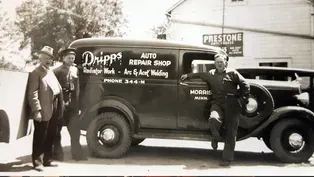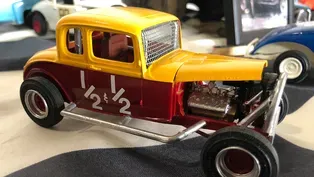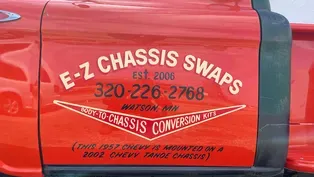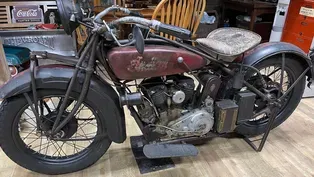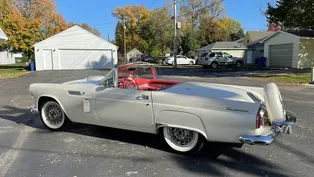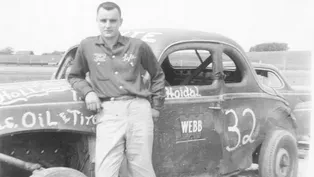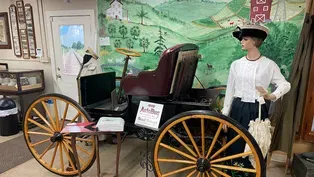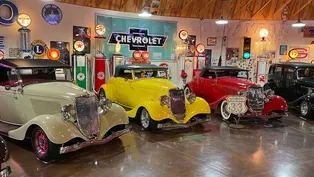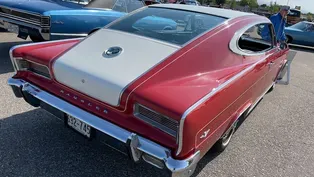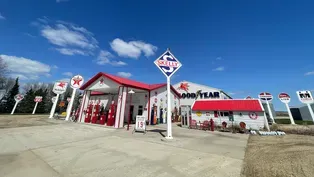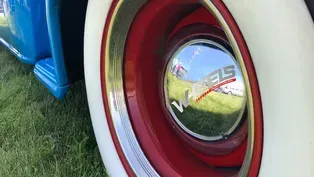WHEELS
WHEELS: Classics & Collections | 1st Gear
5/19/2022 | 57m 45sVideo has Closed Captions
Explore the interesting connection that people have with wheels.
Explore the interesting connection that people have with wheels. Since the creation of the wheel around 3500 B.C. there have been steady improvements and uses for the wheel. Discover wheel stories through people interviewed by Pioneer PBS Production Director Timothy Hale Bakken at regional car shows, threshing bees, farm shows and as they invite him to visit their private collections.
Problems with Closed Captions? Closed Captioning Feedback
Problems with Closed Captions? Closed Captioning Feedback
WHEELS is a local public television program presented by Pioneer PBS
This program is made possible by contributions from the voters of Minnesota through a legislative appropriation from the Arts and Cultural Heritage Fund and viewers like you.
WHEELS
WHEELS: Classics & Collections | 1st Gear
5/19/2022 | 57m 45sVideo has Closed Captions
Explore the interesting connection that people have with wheels. Since the creation of the wheel around 3500 B.C. there have been steady improvements and uses for the wheel. Discover wheel stories through people interviewed by Pioneer PBS Production Director Timothy Hale Bakken at regional car shows, threshing bees, farm shows and as they invite him to visit their private collections.
Problems with Closed Captions? Closed Captioning Feedback
How to Watch WHEELS
WHEELS is available to stream on pbs.org and the free PBS App, available on iPhone, Apple TV, Android TV, Android smartphones, Amazon Fire TV, Amazon Fire Tablet, Roku, Samsung Smart TV, and Vizio.
Providing Support for PBS.org
Learn Moreabout PBS online sponsorship- [Voice-Over] "Wheels: Classics and Collections "is made possible in part by the Minnesota Arts and Cultural Heritage Fund and the citizens of Minnesota and by members of Pioneer PBS.
Thank you.
- My name is Dan Dripps, President of Heartland Motor Company in Morris, Minnesota.
My grandpa started the business back in the 40s in Morris.
Yeah, it was 1940 that picture is from.
My grandpa George and my great grandfather and we don't know who the mystery man in the middle is.
It's from 1940 so we don't quite have that one figured out.
George was a fixer, a tinkerer.
He liked to repair things so he started in radiator business and welding.
And so people would come from miles around because he was a good welder and he would weld all kinds of different things and fix radiators and things like that.
So Dripps and radiators and yeah, made sense.
So he was doin' that and decided to get into the car business.
So he was fixin' cars for people and just real mechanical mind.
And there's a house on the west side of town that's still around that he was selling Oldsmobiles out of his garage basically.
There's cars on the yard that he's got on display and he had a shop there that he would do his repairs out of that shop.
And so I assume he was between the house and the shop was conducting business, got the Oldsmobile franchise in 1941 and was sellin' Oldsmobiles out of his house.
And then in the 50s, he built a dealership down on Main Street.
That building is still down there.
And then my dad took over when he got out of the war.
So Bill's my father.
He took over from his father, George, and he got into the car business then.
And similar, he liked to work on cars and always an interest in cars but he was more of the people person let's say, and more into the selling of 'em and kind of enjoyed that aspect of it.
And then in the early 80s, when things were getting a little tougher then Bill and Bud decided, maybe we'll put this thing together and make a viable deal.
And then Bud took that on to make a viable operation with two, kind of merged two franchises together.
And I came along for the ride in 1984 and still here today.
It's a 1949 and my grandpa sold that new to Alfred Jergenson.
He's a mink farmer from town here and then he traded it in at some point.
And it had just been sitting back on the lot.
It's 30 year old pickup when I'm getting an interest in it and I'm thinking that would be kind of cool to fix up.
So I'm a senior in high school and it was a little project that I thought, well, I'll take that on and fix that up, just restore it, 'cause there's nothin' happening to it.
Like I said, just sittin' there gettin' older and nobody wanted to buy a 30-year old pickup sittin' on the lot and so I thought I'll fix it up.
And, Arnie Golden was a technician for us and little downtime here or there he'd had some body experience, so he'd paint it, I'd sand it.
And you know, we took it apart and painted it one piece at a time, not the ideal way to do a job but our budget was pretty tight, you know?
So we just did it when we had had time to do that.
That's a good story too.
So that Oldsmobile that I have, 1972 Oldsmobile so I'm in the finance office, I don't have any money like my first year or two of, of working in the finance office.
I'm talking to Bud Berger who was goin' to the auctions and I said, hey, if you ever see a car like that, you know, let me know.
And so he called me up in a week or two and says, I have your car.
And I said, no, I said, let me know if you ever see one, I don't have any money to buy this car, you know?
And so well I bought it and so you can just pay me back, you know, I'll just take it out of your pay or whatever.
So it became mine and I had Jim Snowbird in town here at the body shop, he painted it up for me and did some of the restoring for me.
And I've just been dabbling with it ever since.
Kind of a fun car and just got a good story behind it and had it at my wedding and those types of things, just memories that you can't replace.
A lot of people wanna buy it then I'm just like, oh no, then I don't have it.
I can sell it or I can, or I can keep it.
I'll just keep it.
Back when I started at Berger Chevrolet in 1984, there was a car show.
And even before I started that, they did it for a couple years.
I'd bring my old truck out to the car show and it was kind of fun event.
And it just faded away, only a couple years.
So probably '86 or so it went away.
And we decided with the new facility that we wanted to bring people to the new facility and show people what Morris had to offer 'cause car shows are a regional deal.
So we brought that idea back and it's just grown every year since we did it.
So it's a free car show for anybody that wants to show up, anybody that wants to bring a vehicle.
We're not in it to make any money or anything.
We just want to bring people to the community and show off their cars.
And we're car people and there's a lot of car people out there.
So it's a very fun event, a family event that we bring to the community and nobody's making any money off.
It's just people getting together, havin' some fun.
- My name is Lyle Hoidal, drove stock cars for many years, about 30 years.
You get deeper into it the longer you're at it.
Some good years, some bad years.
Spent quite a bit of time upside down.
Hey, that's all part of it.
And you're out there to win, you're not to make friends.
My brother, Bernie, he raced too down here and we built our cars in this, the building on the south end of Main Street of Holloway.
That's where it all started.
My brother, Bernie was kind of a father to me because Dad got killed in that junction going to Morris, Highway 12 and 59 junction.
I never knew him so Bernie was kind of a, a dad to me and he liked racing too.
When I got mine built and he watched me go around a couple times, he says I gotta have one.
And he had that old Mercury sittin' there, chopped it up, made a race car out of it.
Done quite well with it.
He bought old cars and scrapped 'em out and sold parts off of 'em.
We just picked one out of the pile that ran and went racing, I guess.
We went in that old gravel pit that they made into our first racetrack.
They graded it up right on the gravel almost, put some black dirt over the top of it and then bladed it down, watered it.
Yeah, it wasn't the best track but it got us going.
That's me right there.
I was in third place.
- They were fun days.
They were more about, about competition and stuff.
And not all the fancy equipment.
My gosh, we had those little cans and that little tiny, you know, the tire and, and like Ron had at one of the reunions, he said, most of our tires had no hunting on them.
(laughing) But it was fun racing.
People enjoyed it.
It was really fun.
And we knew all the drivers and you know, they were relatives and friends and everybody went to the races.
- But see then if you started out with an old '39 Ford, it wasn't worth nothin'.
It probably would be today.
But you could pick one up in the junkyard easy for just a few dollars.
And that's what you'd start puttin' roll bars in 'em and make a racer out of it.
We made our own stuff.
- Here's the picture of Jimmy Ryman, giving Lyle the checkered flag and he's in 1/2 and 1/2.
- 1/2 and 1/2 was one that I never owned that car.
I just drove it.
Both Bernie and I drove 1/2 and 1/2 at times.
Maynard Shellstad owned it but he never drove a race car in his life.
He just wanted to own that car.
And it was quite a history of 1/2 and 1/2.
That was well used before it come to this area.
It was built up in Morris, Minnesota.
At the very first, we had standing start.
We didn't go around and then they dropped the flag and then start racing.
You lined up, flag man was in between the two lanes of cars.
He told us when to go.
That wasn't the safest place to be really.
There was no mishaps I don't think.
I got my son Scott involved in it when he was 15 years old, didn't even have a driver's license yet.
I think back and I couldn't believe it how quick he caught on.
And he was a very good driver.
He'd done better than his old man.
He kept it.
I don't think he ever had a rollover.
He drove different.
He was actually a better driver.
I would still like to get in one and try it.
- We are in the Wheels Across the Prairie Museum in Tracy, Minnesota.
We have many things at this museum.
There's many buildings and it was kind of built on the idea that wheels helped build the prairie.
My dad, he lived in Racine, Wisconsin, and he did welding and different jobs.
Sometimes people referred to him as a blacksmith.
He did not like that at all.
He is not a blacksmith.
He is a welder.
He happened to find Tracy and I have a little postcard he sent to my mom saying he was in Slayton and he thinks he found the town.
And Tracy seemed to be just the right town.
He talked to some people and he thought it would be a good place to start a shop.
They moved from Racine, Wisconsin.
He brought all the equipment that he could, drill press and whatever he had.
Took them about five trips to get over.
It was 500 miles.
So then my dad started a little shop.
It was behind another building.
His brother was working with him.
One day my dad was downtown above Walt Mulline's store.
My dad was fixing something upstairs and he happened to see this old car.
And he didn't know what the name of it was.
It was dusty.
It was dirty.
There was parts.
So he wanted it.
So he decided that he would have my mom next time she's in the meat market, ask Walt what he wanted for the car.
So my mom did and he said, "well, he would have to take it all apart and haul it out.
Ah, he said, gimme five bucks and he can take it out."
My mom told my dad.
My dad did not sleep that night.
The next morning he was in there first thing, he put a $5 bill on the counter and he said, "I'm taking it out."
So he and his brother had to take the wheels off.
They had to take it apart.
And then they brought it to their little shop and they started working on it.
And I believe in 1949 was the first time he put it in the Box Car Day Parade that we have on Labor Day.
And it's the first car in Tracy that we know of anyway.
He advertised it as the first car in Tracy and put his Firebaugh Welders on there and drove.
And they would dress up in their outfits and drive.
Everybody loved 'em because they were friendly.
They'd go over to the side and wave and talk and carry on so it was really fun.
People were quite surprised to see this car looking like a buggy coming, running down the road.
If it's going wide open, go 25 miles an hour.
But my dad said he would not drive it that fast.
In a parade, you could just go slow enough.
But he would drive around town.
He would go to the bank, the drive-in bank and talk to the people and go around just any old day that he felt like taking the car out.
As far as we know, five were made of this specific model.
They were made in Norwalk, Ohio.
We believe the original cost of the car was $650.
Originally, it had like a cover like on a buggy.
The cover would go over your head so that you could be away from any rain or something.
So it's not mint condition but it's good condition.
It's running condition.
And I can still picture him, cranking it up.
It was three cranks and he would have that running along.
I drove it when I was 16 which was a thrill for me.
(laughing) It's actually quite different than driving a regular car.
It has what's called a fat man steering wheel so whatever size you are, you can pull it forward, you can push it up, so if you're nice and hefty, you can still drive the car, it's way up there.
The reverse is I believe on the right pedal.
Okay, this is the right pedal.
and this would be the reverse.
To start it, it'd be on the left pedal.
You start that and the gas is a little lever up by the steering wheel.
And then the brake is a handle off to the side.
It's not hard.
When you first do it, you're used to a totally different car.
And it's like, well, oh, reverse is down here, it should be up here.
I think I was laughing the whole time because it was so fun.
It's a pretty special car so I want it to stay in Tracy forever so people can see it and enjoy it.
- My name is Virgil Fults of Morris, Minnesota.
My first new car that I bought and it's a 1965 Rambler Marlin and they come out about '65-1/2 and they were competition for the Ford Mustang.
They come out in '64-1/2 and all the companies try to copy 'em or catch up with 'em.
We bought it up in Fergus Falls at the Rambler dealer and we bought it off the floor.
We went up to buy a Rambler, 2-door hardtop.
We got there too late in the season.
They didn't make any '65s anymore.
We had to buy a '66 and they had this one on the floor and it had everything I was gonna get on the hardtop so we ended up buying this one then.
The fastback design was quite a distinction.
But yeah, it was just a flashy little car what it amounted to.
We started out with a 1950 Hudson.
That was my first one.
I was 18 when I got that, just outta school, finally talked my dad into letting me get one.
My dad had a '49 Hudson at the time and they were just the car of the time I thought, you know, at the time.
I'd sold my Hudson to my brother for $640.
Could you imagine?
And that's when I got the Marlin and we bought this straight out, $3,100.
Now you can put a couple zeros on the end of that, this day and age.
They put in what they call a twin-stick overdrive transmission.
It sounds pretty exciting but all it was a floor shift, shiftin' lever on the floor.
Most cars had the overdrives or all the other cars had the overdrive button under the hood lever here, like a hood pull.
They just put it up here for make it, they call it the twin-stick overdrive.
Of all the features I've got in it, that's the thing at the car shows that I take it to and so on, that's the first question I get asked is what's them two levers about and that's all it is that, that lever instead of being a, like a hood pull under the dash why they put it down here on the shiftin' lever, other than that, it's just a regular three-speed.
It's a full trunk but they just made a smaller lid for the design, keep the design lookin' right I suppose.
There are a tire and a jack and everything are in there.
We used to run a roller skating business, a small one, and we had a big box we had to slide in there every time and it fit fine.
It made it all the time.
Then we pulled a trailer beside so it was a good workhorse.
It made a nice family car, could always get about 30 miles to the gallon.
Worked out fine for us.
We drove it seven years as a family car and the family got a little too big so we had to start going to station wagons.
(chuckling) I started buyin' models in 1992, was the first ones I bought.
And I just added to 'em as I went along and I got quite a few for Christmas presents when they knew I was collectin' cars.
And I've got about 90 of 'em now, I guess.
I purchased this Jaguar and this Ford Thunderbird on the same order, I remember.
I don't know why they both turned out yellow but they were.
This one here is a Chrysler Airflow.
When they come out, they were a real outstanding car, but they were completely different and they didn't go over good with the public.
They didn't last long.
Then of course the Edsel.
You know what happened to them?
People didn't like them either so they only made them a few years.
I mentioned this.
This was the model of the first car I owned and had come from England.
And I found it in a ad and I think it was in the "Popular Mechanics."
That was the most expensive car I bought.
It was $104 for that thing.
But it's identical to the first car I owned and I just had to have it.
Christmas time, I got this package I unwrapped it and here was this water painting of my Marlin and a lady from Appleton had painted it for my wife.
My wife stuck one of my pictures out of my billfold of it and she painted it and she really did a super job.
That's hangin' over my desk.
Just a fun car to have around because people just don't know what it is.
Very few people have seen 'em actually.
And they say Rambler, oh, I'd never seen a Rambler like that, you know?
So it's just kind of fun.
- Well, I was born on a farm over near Odessa.
My dad died when I was a young boy and so my mother insisted that I go to college and I went to the university, not knowing what I was going to do.
And I ended up being a funeral director and I've been a funeral director for 55 years.
When I was a young boy, up at Ortonville, the newspaper in Ortonville was owned by the Kaercher family.
And Jim Kaercher, back in the 50s, he had a '55 Thunderbird and boy I really thought that was the cat's meow.
And so when it, I got to thinking about it in later years and I decided to look into it.
I had a '57 first, I bought down in Minneapolis 30 years ago.
Simply I liked these little birds.
But it needed a lot of work.
So I found this car in Michigan, Detroit, Michigan.
So I flew to Michigan and I purchased it there.
And then I had two cars for a while.
And then I sold the '57 to a man out in South Dakota.
And he's since has corresponded with me.
And he's very happy.
He's formed a car club out there and it's been that way ever since.
It's been totally the body off the frame, every nut, and bolt has been removed and replaced, transmission and motor.
It's really a new car, runs like a new one.
The big difference in the '56 is what I like about it is they came with a continental kit, '55s and '57s, you could not put one on, they weren't designed for it at all.
And here's where you fill in your gas and you open the trunk up and then when you were done with filling gas, you pushed the tire back up like that.
The fact is they, we hang that continental tire out of the back bumper, the steering even got a little light.
So '56s were redesigned to carry a continental kit.
And I just thought they looked neat.
You could buy a convertible top and a hardtop like I have.
And the convertible top was manual, you just pulled it up by your hand.
And I think Ford offered it in two colors because he had a lot of canvas in those two colors and so he wasn't gonna spend any extra money.
And I think they're black and white.
The '56 came with the porthole in the top.
You notice the top hangin' there.
They didn't do that in '55 but in '56 and '57, they all had the portholes.
It was kind of unique.
You couldn't put 'em in the trunk.
They were too big so you had to take the top off and leave it at home.
So you didn't want it to rain while you were gone.
This car was actually sold in Los Angeles to a dealer in Los Angeles.
And I've got the actual invoice that was on the sticker on the window.
I think the total price was $2,800, something like that.
- Unlike today, there weren't so many, so many ways to spend your leisure time.
So the stock car racing, you know, for the spectators was a cheap way to do it.
And for the participants, a lot of them were Korean War and World War II veterans.
For them, it was just a fun way to probably drink a little bit of beer afterwards and race their cars.
I grew up in Willmar on the north side, about a block away from the fairgrounds.
And along with a bunch of other north side kids, you know, we gravitated to the racetrack on Friday nights.
That's where we were.
This is the old 1/2 mile track at Willmar shaped like an egg.
There's a certain number of guys didn't care to race there once they raced once, because as you can see, one and two were shaped quite differently than three and four, and you really had to have a handling on your car workin' to make it around it decent.
And more than a few cars were built in the neighborhood.
Guys would bring an old car home and take the glass out of it and gut the interior and just start bracing it, putting in roll bars, went from there.
That's how they got their experience.
I suspect maybe some of the guys they just decided to use maybe like their home address, you know, where they lived like 521 or 503, something like that, 588, maybe that was their, their house address on their street.
There was a time when you saw that quite, quite a bit, not so much anymore.
You still occasionally see it.
It was put together by a friend from Appleton, Glen Schrock, who unfortunately passed away in 2018.
But his dad, Cliff, was a mechanic in Appleton and raced from like '57 to '64.
And Glen tagged along.
And over a period of time, he's put together quite a collection, built quite a collection of 1/25th scale model cars.
His collection is just about 150 cars, Old Coops and coaches like we called them back then from different tracks.
I don't know how long it took Glen to put this together, but it must have taken some time.
And he must have had a lot of pictures, you know, a lot of reference material to get the paint schemes right and stuff 'cause you couldn't possibly all do 'em from memory.
It's quite a collection.
- My name is Vaughn Veit.
I'm the president of Veit Automotive Foundation.
I'm a collector, I guess.
And I started collecting stuff and then I realized that these older guys, they were dying off or retiring and their collections were sold.
So I just decided to start a foundation so mine could stay here permanently for years after I'm gone.
'Cause it's just a part of history, you know, it's evolved so much, the cars and stuff.
I just wanted to save it.
I built a round barn for a showroom.
And this building here is Gothic style.
And I just wanted to kind of keep things 'cause the old barns are disappearing.
I've got the metal toys and trucks I had when I was a little kid.
I've got my first bicycle I got in 1948.
I got duplicate of my second one.
I've got duplicates of my motor scooters that I had.
I've got my first car and the first hot rod I built too.
- My name is Jarrid Roulet.
I'm the curator here at the Veit Automotive Foundation.
And that means that I do the tours.
I do a lot of the history of the different cars throughout the collection, history of any of the Minnesota related objects in the collection.
And when I'm doing the tours, I try and involve our guests that come out here with any of the history and teach 'em new things as they walk through.
Here, we have Tri-Five Chevys and '33 Fords.
We got a great collection of gas pumps and it's always an everyday learning experience, not only for myself, but anybody that's part of our crew here at the foundation.
Every day, there's something new and it just keeps it fresh for all of us.
Documenting the history of the cars and the pumps and those types of things for future generations is super important to what we do.
- I like '33 Fords.
They were a one-off car.
The front ends are delicate and feminine looking.
And that's the only way I could describe 'em.
The first time I saw 'em I fell in love with 'em.
I think I own 20 of 'em.
I have every body style in '33 Ford.
In fact I have the first '33 Ford ever built serial number 001 and it's a prototype.
And we're restoring that now.
Almost all of 'em have stories.
Some of these got a lot of history to 'em.
It's just part of the hobby, you know?
But I like the historical part of it too.
Grandfather's windmill off his home farm in Rockford, Greenfield Township.
That was the only thing left on the 80 acres and I tried to buy it from the guy for 20 years.
Finally I took my 80-year old aunt out there and she used to date this farmer and she talked him into selling it to me.
And I moved it out here, restored it, moved it, and put it here.
And different things, I've got a lot of old stuff from families from the farms and stuff like that, tools, different things, just hanging on to history.
- Every day, it's something fresh.
And if you're not learning something whatever, it's because you're not paying enough attention.
It's a pretty fun place to be.
And so like I say, every day is a new adventure.
- My business is E-Z Chassis Swaps which is conversion kits to put classic and vintage trucks on more modern, safer chassis so they're drivable.
And also Ed's Auto Welding what we're standing in front here is the shop where we put 'em together for customers.
We're in Watson, Minnesota.
The business downtown that we have, the E-Z Chassis Swaps.
This is where we put the kits together and ship 'em out of there.
We ship in Granite Falls at UPS so you'll see me running down there to ship the boxes.
I started with a small room and this shop in the back, realizing not long after that, that it was gonna get outgrown.
It was just too small.
So we found the old abandoned cafe downtown which was a very busy cafe in its day, the Watson Cafe, has a long, long history, but I can see a diamond in the rough, be it a vehicle, be it a building.
So it's making use of another building that normally would've been tore down.
Projects that we're working on now, we have a '42 Chevy Dually that's gonna be a working dump truck for this guy's business.
He's out of central Colorado.
That's on a 78 One-Ton.
We have a '47 Chevy truck here that is a gal from Texas, it was her great grandfather's truck from the Worthington area and she has a farmer's market business so it's a stake bed truck, and she's gonna use it as a calling card.
- This is our '58, 4-by-4 that we used to create the kit that I'm selling today.
It is one of our hottest selling kits, '58 on a '79 4-by-4.
This is our Betty Lou, which is on a Caprice.
We drive that around.
This is a 4-wheel drive.
We also have a '59 in the shop right now.
It's a '59 long bed on a 4-by-4 chassis, a '79 but it's got a 2003, 6.0 V8, modern V8.
And it's what you call patina.
A lot of these are patina which means it's got weathered paint.
That's what people want instead of the nice paint, they have to worry about.
What I know about this garage, it was built in 1962, it was a Texaco gas station, and then later turned into an independent or actually it was a Co-op brand gas station and then went to independent.
It was owned by Harrison Harriet Molden known as the Molden's Garage.
They had three tow rigs to go rescue wrecks and people out of the Lac qui Parle River, goin' through the ice.
One of my favorite projects here, it's a shop truck called "Blue Angel."
This was my uncle's original tow truck that he bought new in 1970.
As far as I know, it's the only new vehicle he ever bought.
I rescued it from being scrapped.
We recognized it as my uncle's old tow truck.
It was in the first Ivanhoe Parade in '71 and they had their 50th anniversary this last year of that parade.
And my cousin, Ken, was the honored driver and sadly Ken passed away.
That was the last time we saw him but that was a great day.
We got it running just the day before the parade and ran it through the parade.
It means a lot to me.
It is a tribute to my uncle, uncle Clarence, who was a World War II veteran, served in the Army, Air Force, whatever in a B-17 bomber, came home and started his own business out of real humble beginnings, called it Lipinski Garage, grew it, he worked till his 80s in that garage and now his grandson, Chris took over.
It's still open today in Ivanhoe, Minnesota I'm doing what I love to do in my later years.
Here I am livin' my dream, 61-years old with more work than we can handle.
- I'm Wally Kill from Morris, Minnesota.
And I'm a collector.
Started out as just a fun project, but it kind of ballooned into more than that after people started stopping in to look at it, I guess.
I didn't build it for a museum or anything.
It was just for my own enjoyment.
I had all these signs and stuff, scattered around and stacked in the corner in my pole shed and I thought, wow, I'm gonna put this model gas station up so I can display 'em nicely in there.
And so I that's what I did.
On gas and oil products, I started about 30 years ago.
A friend of mine had two gas pumps that were given to him and he offered if I would restore both of 'em and he'd keep one and let me have the other one so that kind of started the gas pump collecting.
And then after that, I looked around and hey, this one's way different than the one I've got now.
And one led to probably 60 or 70 that I have now.
I purchased this old wrecker truck that originally came from Benson, Minnesota.
And I decided that was a 1955 Chevy wrecker.
So I just started searching for a '55 Chevy to hook up behind it.
And I now have it situated so it looks like the wrecker's towing the car in.
The other old pickup by the tree actually is a '48 Chevy that I had acquired when my brother passed away, something he'd collected.
Well, I lean towards the Chevys, I guess.
I really am not into the Ford restoration business.
I love Chevys, I guess.
That's kinda ironic because majority of my tractor collection is Ford tractors and I've got probably 25 different Ford models of Ford tractors that I've collected over the years.
But no cars.
I've had quite a few car clubs make this their cruising destination.
They just stop in, you know, for an hour or so and check things out on like a Sunday afternoon or something.
And that's kind of fun.
You get to see a lot of old cars.
There's a few younger kids that come and they are just in awe of how these gas pumps all look different.
And each one is so unique and different.
And I like to restore 'em and keep it alive for history.
It must be a passion.
You just get started on it and one thing leads to another, I guess.
- My name's Kevin Backstrand from Ortonville, Minnesota and I own the Old American Bike Barn.
I would describe the American Bike Barn as a place to come and view old motorcycles.
We built it so people could enjoy our stuff rather than have it in our garage.
I've been collecting motorcycles for probably 20 years now.
We invite the public to come in and enjoy what we have and what we've collected.
We have fun with people that come in and that's what the whole deal about these old motorcycles is talking to people.
And everybody has a story that comes in about an old motorcycle so it's pretty neat.
- My name is Tina and I'm Kevin's business partner here at the Old American Bike Barn.
He knows everything and pretty much everybody in the bike industry just from Harley's to Indians.
He's just my mentor.
He teaches me about bikes and I grew up around race cars.
I don't know a whole lot about bikes.
My son races for World of Outlaws, Josh Richards.
He's a four-time World of Outlaw champion.
He drove for Lucas Oil the last two years and he won a Lucas Oil championship.
So I've known a lot of people through the racing industry.
I mean, every day is new and exciting.
This is truly my dream job.
- We took this building down.
It was across the road from John's Auto Wrecking down in Odessa.
We bought it from John.
It was the old county barn.
And I spent many hours sitting in that barn dreaming before we took it down.
And we had Todd Close and his family tore it down.
They marked all the timbers to know how everything had to go back together.
1890s, that barn was built.
It was all the timbers and whatnot were all joining together.
And wooden pegs put the barn pretty much the whole framework together.
And it was very sturdy when it come down.
We used the whole barn up except for the one wall we did not have enough room for.
We got that from Jerry Long Henry, the Granite View Farm sign out there.
That's from Jerry's barn.
A lot of people recognize that when they come in here because it stood there for years.
It's a pretty neat piece to have in here.
- We have Jim.
He's the old guy in the back, really dependable, he's I don't know, maybe 100-years old but he got employee of the month last month.
And he shows up every day.
Jim came here from Barrett Jackson in Arizona.
We've had him probably two or three years and he became, he came to work for us last month.
He was employee of the month, best employee we ever had.
He never talks back.
- A big dream and an old barn made it happen.
It makes me feel good to come to work.
- [Voice-Over] "Wheels: Classics and Collections" is made possible in part by the Minnesota Arts and Cultural Heritage Fund and the citizens of Minnesota and by members of Pioneer PBS.
Thank you.
Dan Dripps - President - Heartland Motor Company
Video has Closed Captions
Clip: 5/19/2022 | 5m 57s | Generations of the Dripps family have been involved in the automotive business. (5m 57s)
Doug Schriener, Models Stock Cars & Stock Car Racing History
Video has Closed Captions
Clip: 5/19/2022 | 4m | The history and culture of the early days of dirt tract stock car racing. (4m)
Ed Lipinski - Owner - EZ Chassis Swaps
Video has Closed Captions
Clip: 5/19/2022 | 5m 19s | Ed Lipinski tells about his EZ Chassis Swap work and the history of his garage in Watson. (5m 19s)
Kevin Backstrand - Owner - Old American Bike Barn
Video has Closed Captions
Clip: 5/19/2022 | 5m 19s | A repurposed rural barn built to display classic Indian and Harley Davidson motorcycles. (5m 19s)
Lorwin Zahrbock - Owner - 1956 Ford Thunderbird
Video has Closed Captions
Clip: 5/19/2022 | 4m 30s | Lorwin Zahrbock talks about his Classic 1956 T-Bird Convertible. (4m 30s)
Lyle Hoidal - Classic Stock Car Racing
Video has Closed Captions
Clip: 5/19/2022 | 7m 12s | Lyle Hoidal talks about his days as a dirt track stock driver. (7m 12s)
Marcy Schramm - Historian - Wheels Across the Prairie Museum
Video has Closed Captions
Clip: 5/19/2022 | 6m 48s | The First Car in Tracy, MN was a 1906 Auto Bug. Marcy Schramm talks about this unique car. (6m 48s)
Vaughn Veit - Veit Automotive Foundation and Museum
Video has Closed Captions
Clip: 5/19/2022 | 5m 17s | An overview of the Veit Automotive Foundation & Museum with Vaughn Veit and Jarrid Roule. (5m 17s)
Virgil Fults - Owner - 1965 Rambler Marlin
Video has Closed Captions
Clip: 5/19/2022 | 6m 44s | Virgil Fults owns a 1965 Rambler Marlin and showcases his model car collection. (6m 44s)
Wally Kill - Owner - Classic Service Station and Collection
Video has Closed Captions
Clip: 5/19/2022 | 5m | A Classic Service Station built to display a collection of automotive memorabilia. (5m)
WHEELS: Classics & Collections | 1st Gear
Preview: 4/29/2022 | 30s | Explore the interesting connection that people have with wheels. (30s)
Providing Support for PBS.org
Learn Moreabout PBS online sponsorshipSupport for PBS provided by:
WHEELS is a local public television program presented by Pioneer PBS
This program is made possible by contributions from the voters of Minnesota through a legislative appropriation from the Arts and Cultural Heritage Fund and viewers like you.

